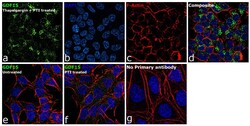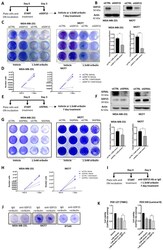Antibody data
- Antibody Data
- Antigen structure
- References [1]
- Comments [0]
- Validations
- Immunocytochemistry [1]
- Other assay [1]
Submit
Validation data
Reference
Comment
Report error
- Product number
- 42-1700 - Provider product page

- Provider
- Invitrogen Antibodies
- Product name
- GDF15 Polyclonal Antibody
- Antibody type
- Polyclonal
- Antigen
- Synthetic peptide
- Reactivity
- Human
- Host
- Rabbit
- Isotype
- IgG
- Vial size
- 100 μg
- Concentration
- 0.25 mg/mL
- Storage
- -20°C
Submitted references GDF15 Is an Eribulin Response Biomarker also Required for Survival of DTP Breast Cancer Cells.
Bellio C, Emperador M, Castellano P, Gris-Oliver A, Canals F, Sánchez-Pla A, Zamora E, Arribas J, Saura C, Serra V, Tabernero J, Littlefield BA, Villanueva J
Cancers 2022 May 23;14(10)
Cancers 2022 May 23;14(10)
No comments: Submit comment
Supportive validation
- Submitted by
- Invitrogen Antibodies (provider)
- Main image

- Experimental details
- Immunofluorescence analysis of GDF15 was performed using 70% confluent log phase HCT 116 cells treated with 1 µm of Thapsigargin for 16 hours and PTI. The cells were fixed with 4% paraformaldehyde for 10 minutes, permeabilized with 0.1% Triton™ X-100 for 15 minutes, and blocked with 2% BSA for 45 minutes at room temperature. The cells were labeled with GDF15 Polyclonal Antibody (Product # 42-1700) at 5 µg/mL in 0.1% BSA, incubated at 4 degree celsius overnight and then labeled with Donkey anti-Rabbit IgG (H+L) Highly Cross-Adsorbed Secondary Antibody, Alexa Fluor Plus 488 (Product # A32790), (1:2000), for 45 minutes at room temperature (Panel a: Green). Nuclei (Panel b:Blue) were stained with ProLong™ Diamond Antifade Mountant with DAPI (Product # P36962). F-actin (Panel c: Red) was stained with Rhodamine Phalloidin (Product # R415, 1:300). Panel d represents the merged image showing cytoplasmic(Golgi complex like pattern) localization. Panel e represents untreated cells . Panel f represents cells treated with PTI alone. Panel g represents control cells with no primary antibody to assess background. The images were captured at 60X magnification.
Supportive validation
- Submitted by
- Invitrogen Antibodies (provider)
- Main image

- Experimental details
- Figure 5 GDF15 contributes to the maintenance of the DTP state in cells responding to eribulin. ( A ) Schematic representation of siGDF15 experiment and following 7-day eribulin treatment. ( B ) WB analysis of GDF15 protein in siCTRL and siGDF15 cells. Normalization was carried out with Actin as a loading control. ( C ) Representative image of crystal violet staining in siCTRL and siGDF15 cells treated for 7 days with the vehicle and 1.5 nM eribulin treatment. Graphs (right panel) show the quantification of cell viability in siGDF15 cells during eribulin treatment compared with siCTRL cells. ** p -value < 0.01, **** p -value < 0.0001. ( D ) Cell-counting experiment performed in siCTRL and siGDF15 cells after a 7-day vehicle and 1.5 nM eribulin treatment. The graphs show higher sensitivity to eribulin of siGDF15 cells compared with siCTRL cells. The graph for each cell line shows the mean viable cell number +- SD calculated from three independent experiments. ( E ) Schematic representation of siGFRAL experiment and following 7-day eribulin treatment. ( F ) WB analysis of GFRAL and GDF15 protein in siCTRL and siGFRAL cells. Normalization was carried out with Actin as a loading control. ( G ) Representative image of crystal violet staining in siCTRL and siGFRAL cells treated for 7 days with the vehicle and 1.5 nM eribulin treatment. Graphs (right panel) show the quantification of cell viability in siGFRAL cells during eribulin treatment compared with siCTRL cells. ** p -value
 Explore
Explore Validate
Validate Learn
Learn Western blot
Western blot Immunocytochemistry
Immunocytochemistry